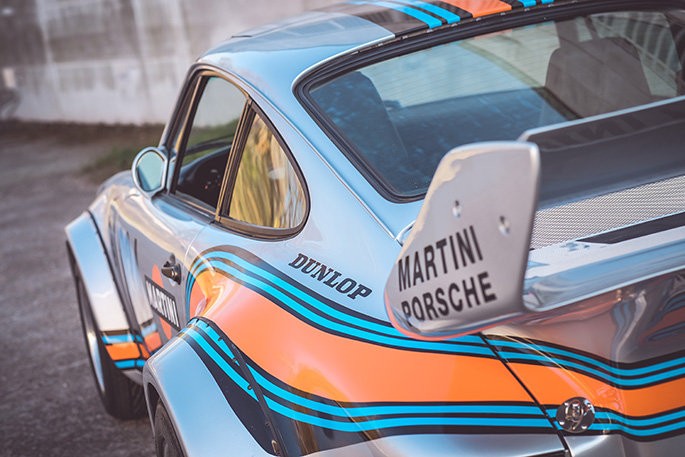When you meet Dr. Erik Brandenburger and his fleet of vehicles, you think you‘ve seen everything. Diverse rally Porsches, Safari beetles, Lancia Delta Integrals, 911 RUFs and MAN Ruthann’s trucks are certainly well known to the attentive reader. At the sight of this particular fleet even the Porsche guru Magnus Walker would go green with envy. And after every photo shooting session, you think that‘s it, you can’t top that. And then, just a few weeks ago, a short e-mail arrived with a little photo as an attachment ...
Engine size, torque, price, acceleration, top speed – all of them unquestionably interesting parameters in the automotive field, but they wouldn’t do the Porsche 934 justice. In this case, another value is used for cold forming of the spine, backfiring in the nose and gas bubbles in the stomach. This value is at worst 2.3 and at best 1.88, and no, this has nothing to do with the charging pressure of this raced-tuned Porsche 930 brute of a car. It is the power to weight ratio in kw/kg and indicates how many kilograms each horse has to pull. The more favourable the value, the more considerate the driver is when pressing his foot on the accelerator pedal and when handling the steering wheel, or else he is liable to find himself the dubious star of a police report the following day and possibly condemned to spending an extended period of time riding his bicycle. Instead of sitting on a padded gel saddle, the owner of such a Zuffenhausen missile much prefers to recline in his Recaro sports seat and can only confirm that the utmost caution is absolute priority: ”That really would be an expensive way of doing things and could result in the car being put up for sale again. When I found it a year ago on the mobile.de website, the 1986 911 Turbo had some serious damage to its front end and I purchased the written off vehicle as a rolling chassis.“ So, take a deep breath, the Doc is not going to terrify northern Germany in a factory-built 934. Instead of having at least 485, 540 or even 600 hp delivered by the 934s that were built in 1977 and 1979, this one will “only” put out 300. The original powerplant 30 years on, this Porsche fan discovered, first deserved to be checked over by the manufacturer in Stuttgart. Two weeks after buying the vehicle, he managed to talk the same seller, who happened to represent the bored Hungarian joint heirs to the junk that had been lying around for some 18 years, into letting him have the engine, the four-speed transmission and the seats – while on his way to Sylt…
The Group 4 classification at that time permitted virtually no body changes to racing cars related to the 930 series model. The only changes, therefore, were the fibre-glass flared wheel arches that were riveted on to add a total of 100 mm to the car’s width – the body of the Turbo was quite flared anyway. The low slung front spoiler directed cooling air through outer air inlets on both sides to the two water/air heat exchangers of the intercooler, while the two inner inlets sent a cool breeze to the front brakes and a venting slit in the middle concealed an oil cooler. The luggage compartment was occupied completely by a 120-litre fuel tank fitted with two fast-fill filler necks, the compulsory fire suppression system, the oil tank that had been removed from the engine compartment and the battery. Since the ruling prohibited the use of light Plexiglas windows, the standard glass windows were retained, some reinforcement was permitted, however, to increase torsional rigidity. In order to compete in Group 5 of the World Championship for Makes and to have more options for modifying the body, some teams build up their 934s to meet Group 5 specifications, which included the 935-type double-decker rear wing. The body kit is available from under the counter in Zuffenhausen and, following the successful modification, the vehicles were then designated Porsche 934/5s. And that is precisely what Erik had had in mind ever since he‘d set eyes on this sensational feature in the relevant men’s motorsport magazines. But it was placed first of all on the Celette straightening jig, where experts added a used, but healthy front section to the wrecked Turbo. The 930 was then driven in stately fashion by trailer to DP Motorsport, whose work never fails to amaze Erik: “This fantastic professional business run by the Zimmermann family looked after the entire exterior finish and the modifications to the bodywork. Then the lads in the Lauest Schmidt bodyshop in Norderstedt took over and did an impeccable job of painting the carbody in the original silver metallic. When it was all over, the only thing to be said was ”Come to Daddy!‘“ The striking Martini Racing livery was also added in Norderstedt by Ohlala, a local company, with not a crease or a bubble to be seen, which meant that the work on the exterior was now completely finished and chassis was fully in order. The GT racing car still required some close-to-production changes; suspension, shocks, axles and brakes still needed to be modified. Fortunately, the Porsche 930 ex-works had already been blessed with a very robust suspension system, so that the front wheel bearings and the cast aluminum trailing arms at the rear taken from the series with the harder uniball spherical bearings could be retained. Nevertheless, our Hamburg doctor made sure he got hold of the upgrade. The high vehicle weight of 1,120 kg that had resulted from the GT ruling required reinforced shock absorbers to increase safety at high speed. The torsion springs fitted as standard were supplemented by height-adjustable coil springs. A tubular anti-roll bar was included at the rear and antiroll bars from the Porsche Carrera were used on the front axle. With a top speed of over 300 km/h, solid braking power was a must, with the result that the experts decided to go for Porsche 917 parts. The vehicle was fitted with internally vented and cross-drilled steel brake discs with four-piston aluminium calipers all round. To speed up wheel changes and increase strength, the five-hole hubs were replaced by centre locking hubs. The 934 was fitted with 275/600 tyres at the front and at the rear 325/625s mounted on 10 and 12.5-inch wide, three-piece 16-inch BBS rims respectively. The doctor bypassed this detail regarding the wheels that is totally impractical for normal day-to-day driving by completing the rest of the work with three good men from the Porsche scene. The car now has 9x15 Füchs rims fitted with 225/50 tyres on the front wheels, while 14x15 rims from the same manufacturer on the driven axle fitted with even wider 345/40 tyres provide enough traction at the rear .
Typical for a racing car, the cockpit of the Porsche 934, compared with the standard production 930s, was quite bare: the driver was clamped into a racing bucket seat fitted with a six point safety harness, while the passenger seat, rear seats and floor covering had been thrown out. Instead, the car was fitted with an aluminium roll cage, and to the standard instruments, such as the rev counter, oil temperature and pressure gauges, were added gauges for boost pressure and fuel delivery. The speakers in the panels and the radio could easily be dispensed with, since the doctor has a special recipe to deal with distress and boredom: a finely-balanced K27 single-scroll turbocharger right behind a twin pipe stubby exhaust! The menacing growling they emit gets attention faster than a police siren, while the leaping flames produced by the overpressure from the side-mounted wastegate pipe take over the job of the flashing blue light. It‘s no surprise, therefore, that when the doctor gets behind the steering wheel he mutates into someone taking dopamine boosters. “Oh most definitely, driving is such fun! He takes off like nobody‘s business and goes through curves at such amazing speed that puts the wind up unwary passengers. But the general public, which is typical for Germany, looks on the Porsche very sceptically and there are only a few women who fall in love with the car. But this is compensated for by the many drivers who drive too close behind.“ They have to, of course. If they can’t see the name on the back of the car then they wouldn’t know the name of the flying monster that is about to disappear into the distance. Taking off into the blue, by the way, could well be completed much faster in future, ever since Erik returned from France with half a salvaged 935 hill climb car, including the 650 hp Boxster Bi Turbo engine: ”So, if the present turns out to be inadequate, then – let’s give the thing a try!!!
Fotos: Marcus Krüger WWW.PHOTO-KRUEGER.DE, Text: Arild Eichbaum

















